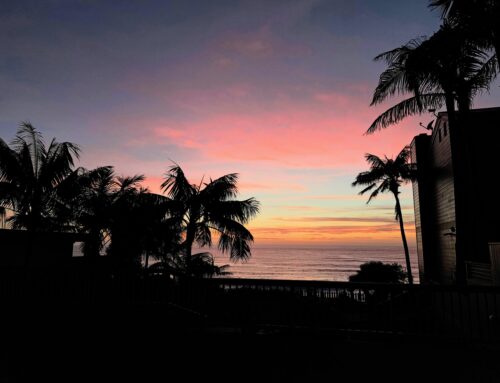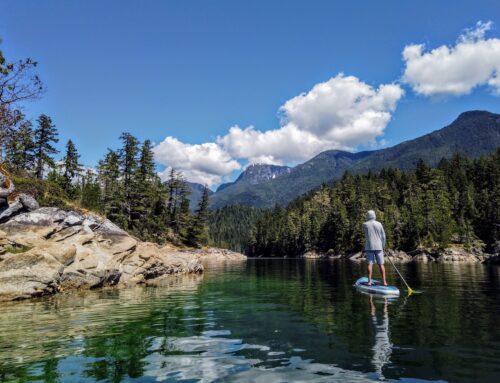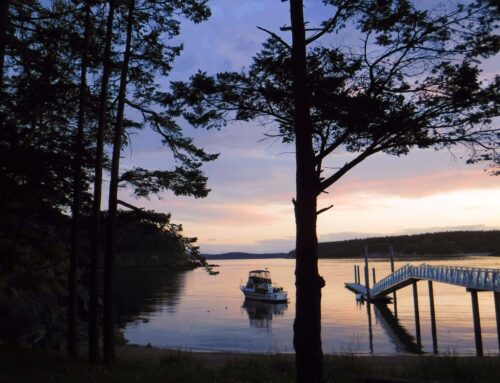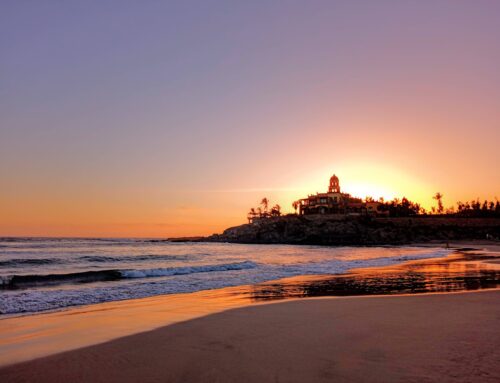 This article was also published in 48° North Magazine – a great, free sailing magazine for the Pacific Northwest. You can read it here starting on page 45. It was also published on the Women and Cruising website – a great resource for women cruisers. Click here to view my other published articles.
This article was also published in 48° North Magazine – a great, free sailing magazine for the Pacific Northwest. You can read it here starting on page 45. It was also published on the Women and Cruising website – a great resource for women cruisers. Click here to view my other published articles.
It’s been nearly a year since we sold Camille and we’re starting to think about our next boat. We’ve had a nice break but the sea is calling.
When we were boat shopping before we bought Camille, we had some ideas on what we wanted out of a boat but did not have a specific make or model in mind. We looked at everything from 30-year-old blue-water boats to brand new fin keels. This time around we know exactly the make and model we want to purchase. We’re just waiting for the right boat to come along.
Camille ended up being sort of a practice boat to determine what we really wanted out of a cruising boat. Turns out there are a few things we will not compromise on in the future. We’ve had some time to reflect and made a list of what we learned.
WHAT WE DID RIGHT WITH OUR FIRST CRUISING BOAT
Upgrading
We bought Camille at a rock-bottom price because the previous owner had fallen on some bad luck and had to short-sell. This allowed us to make extensive upgrades and still come out even when we sold Camille two years later (more about our cruising expenses here). She had been very well taken care of and we continued babying her. Her hull looked whiter and shinier than most near-new boats. We didn’t affix anything permanently by making holes in the wood or made any “weird” modifications. All this added to the resale value.
Age
We made sure to buy a boat under ten years of age. Older boats tend to need lots of TLC and repairs. They need new rigging, new sails, new electronics, new hoses, etc. We sold Camille right when we were starting to think about needing to replace a few major systems. The next boat will need to be even younger so we can keep her for longer and be more confident in her integrity.
Size
For our first cruising boat, Camille, at 38 feet, was the perfect size for the two of us; and in the future, we have no plans of going any longer. The forward bunk is too small for two guests so they ended up sleeping on the convertible bunk in the saloon – not ideal.
Watermaker
In the late ’80s, when I was in my teens, my parents and I sailed from Germany to California sans watermaker (more on that journey here). We used salt water for nearly everything and I don’t like the feel of dried salt on my skin or what it does to expensive gear. So when Mike and I bought Camille I knew I would not go anywhere without a watermaker. We added a 110V high-output watermaker to Camille (more on that here). It was great having tons of water but every third or fourth day we had to listen to a very loud water-pump for 3-4 hours to fill our tanks. We also had to run this portable gas generator to power the 110V pump. We don’t like having gasoline on board (we are even considering an electric motor for the next dinghy) and the smell from the exhaust of the generator is not very pleasant – not to mention dangerous. We will definitely have a watermaker on our next boat but it will have to be powered by either a diesel generator or the sun. 
Navigation
Shortly before leaving the US, we bought an iPad with the Navionics navigation app. Since we also had two iPhones and a hand-held GPS we had lots of backups to our chart plotter. I wrote extensively about using our iPad versus the chart-plotter here. We had to replace the GPS antenna on the chart-plotter twice. The original antenna was fading in and out when we bought the boat. The second antenna which we had bought from some guy on our dock failed a year later. Reading the forums, this seems to be a known issue with older Raymarine GPS antennas (ours was seven years old). We contacted Raymarine and they simply told us to buy the new model which required an expensive NMEA converter. Glad we had the backup GPS units!
Camille came equipped with a Radar which we were very glad to have when we encountered dense fog off the coast of Baja. A definite must-have on our next boat.
We added a new VHF with an AIS receiver which is just another layer in assuring we don’t get too close to other boats. Next time we would love an AIS transceiver but neither is a must-have. The boats that broadcast an AIS signal are usually well lit. It’s the little boats without lights we have to worry about. And nothing replaces good old-fashioned watch keeping.
LED Lights
After trying many different brands of interior LED lights we finally went with Imtra LED lights for the cabin lights. Most LED lights give off a bluish/cold hue that makes me think of a cafeteria. The Imtra lights were the warmest color I could find and kept the cabin feeling cozy. Update: On our current boat we are using the Lunasea warm LEDs which looked warmer to me this time (I again purchased several different brands to test out).
We also changed the navigation lights to LED. This was especially helpful for the anchor light. Many boats will use the cheap solar garden lights as anchor lights to save on electricity. This is not legal and makes them very hard to see. A real anchor light (at the top of the mast, where it belongs) will light up the water for long distances and makes it easy to spot a boat. Coming into an anchorage late at night to find many boats badly lit can be very dangerous. Please, buy an LED anchor light!
Swim-Step
This was something we always knew we wanted in a cruising boat and was very high on the must-have list. Camille’s swim-step was huge. Great for showering and rinsing off after spending time in the ocean. And since we did not have a separate shower stall we usually showered outdoors. A shower stall had been high on my must-have list but without a way to easily dry the room, it can cause moisture problems.
The swim-step is also great in marinas. When the boat is backed into a slip it is easy to step on and off. Much safer than rickety steps to climb up the side. Maybe I’m just clumsy but I have fallen between the dock and the boat on a couple of boats — once nearly splitting my head open on a concrete dock climbing over the bow.
Ventilation
Camille had 16 opening ports including three large hatches forward. We had one of these wind-scoops to funnel the breeze into the cabin but actually only used it a couple of times since it did not really make much of a difference. For windless nights we had four powerful cabin fans (more on those below).
Communication
We purchased an inexpensive WiFi booster to receive free WiFi signals from shore. We never felt the need for an expensive unit that is permanently affixed high-up in the mast. By simply sticking it out of the window in an anchorage we usually found an open signal. UPDATE: We now have a cellphone plan that works all over the world. We have used it for data in Mexico, Canada, and the Bahamas without issue.
Other things we loved about Camille
- Lines led aft into the cockpit
- The huge galley that also had spaces to wedge into in big seas
- Arch for traveler keeps the cockpit clear of lines
- Electric winch (Mike likes to go aloft)
- Vacuflush head (no stink!)
- Solar panels
- Lots of easily accessible storage
- Check out our list of Favorite Gear
WHAT WE WILL DO DIFFERENTLY ON OUR NEXT BOAT
Upgrading
When we bought Camille we bought an almost barebones boat. We added solar, bimini, watermaker, dinghy, outboard, liferaft, anchors, anchor chain, and tons of safety gear and spares. We spent over $20,000 and did most of the work ourselves over a period of three months. Having everything new was a major bonus but the installs took a lot of our time that we could have spent cruising. We don’t have unlimited time to cruise since we still have to work, so we should enjoy every minute of our time off.
Watch-Standing
We usually stood our night-watches under the protection of the dodger, especially if it was a cold night, using the iPad to keep an eye on progress. The problem with this location was that all the instruments were on the binnacle. If the auto-pilot stopped or the AIS alarmed or we had to keep a very close eye on the Radar we had to sit behind the wheel – exposed to the elements. The next boat will need a more convenient location for the instrument panel or repeaters inside of the dodger or at a nav desk with windows.
VHF
We had one VHF radio at the helm as well as a couple of handhelds. Most popular cruising grounds have VHF “cruisers’ nets” in the mornings to exchange information and goods. The time of the net often coincided with breakfast preparations aboard Camille so we tried using one of the hand-held VHFs but could not pick up parts of the conversation. Unless we were right at the heart of the cruising grounds we had to use the high-powered VHF at the helm to listen in. Having a second, high-powered VHF in the cabin would gave been a great addition. Not to mention having a backup radio that is not exposed to the elements.
Power
We added 300 watts of solar to Camille but there was no space for a second battery. Our one Group-4D battery was not enough to power everything we needed to run. The fridge was a power-hog in the hot Mexican sun. During the day we were making more electricity than we could store and at night the battery could not keep up with demand.
Autopilot
The autopilot on Camille was not adequate once she was fully loaded with cruising gear. It was rated for 24,000 pounds of displacement – Camille displaced about 16,000 pounds empty. Add water, diesel, and gear and you reach the limit very quickly. In largish following seas or if it had to make a lot of corrections the autopilot drive stopped and had to be reset. We looked into buying the more powerful model but would have had to replace the chart-plotter at the same time resulting in many boat bucks (one boat buck = US$1,000.)
We had looked into adding a self-steering wind-vane to Camille but since we were not planning on any major ocean crossings the expense would have been prohibitive.
Noise
Camille was very noisy. In a rolly anchorage, the creaking drove me nuts. I could not sleep. I ripped apart lockers looking for the source. I added little pieces of material between areas that were rubbing. It always came back. Under sail, we could not simply enjoy the sound of the waves slapping the hull because the creaking drowned it out.
Under power, the noise was even worse. With the engine located right under the stairs, the engine droned on in the main cabin and in the aft cabin. The only place that was somewhat quiet was the V-berth which is more akin to riding a roller-coast when the seas kick up.
Bunks
Camille had basic, thin foam cushions in her bunks. We should have just gone ahead and purchased a custom folding marine mattress (I wrote this before I knew about latex mattresses, which are the best in our opinion). Instead, we purchased the Froli sleep system and more foam – almost spending as much as for a real mattress. We had no moisture issues but were never really very comfortable. Next time we’ll just get a real mattress on top of some of this to keep things dry and ventilated.
Windows
My biggest complaint about our boat was that I could not see out of the windows. It felt like living in a hole when not in the cockpit. Mike is quite a bit taller than I am and was able to see out of the windows while standing up. The boat was very bright and airy thanks to large windows on deck but in the hot sun, we usually had to keep all the windows and hatches covered. I would like to be able to look out the windows while doing dishes or sitting in the saloon. It seems silly to travel thousands of (hard-earned) miles to stare at the walls when right outside is a breath-taking anchorage.
Stairs
The 6-step companionway made the cabin feel very disconnected from the cockpit. At anchor, this was a mere inconvenience but at sea, it was a pain having to go up and down the stairs carrying food or drinks – one item at a time. I longed for more of a “porch” where the cockpit is an extension of the cabin.
Deck Color
Camille’s deck was two-toned. The main walking-areas were painted light grey and everything else was white. If I had not felt it for myself I would not believe the difference that made. I could not walk on the grey areas on hot, sunny days because they would burn my feet. The white areas felt merely warm. I can only imagine how much cooler the interior would have been with all-white decks.
Cabin Fans
We purchased four of these 2-speed Caframo cabin fans. After one year of average use, they became very noisy and were slinging black dust. My parents, who cruised Mexico on a Hunter 455, had these Hella fans on their boat for several years and they were quiet and low-maintenance.
Dinghy Davits
While we would prefer not to make any passages with a dinghy in the davits, having davits at anchor would have been a great addition to Camille. Most nights we left the dinghy in the water and it would either rub against the hull or we would worry about it getting stolen. When the wind kicked up we had to pull it up on deck but not until we heaved the outboard on deck. This was always a huge production that could have been avoided with davits. Of course, the swim-step would not have been very usable with davits and that was one of our favorite features of the boat.
Bottom line: Even if the next boat does not have all of the options we want, we can always add them. The basic layout of the boat, however, cannot be changed. We will make sure the boat doesn’t creak, that the beds are large enough to be comfortable and that the boat makes us feel safe. We can’t wait to go cruising again!
UPDATE: In December of 2015 we purchased our second cruising boat. When writing this post, I did so with a Lagoon catamaran in mind to cruise the Coconut Milk Run. After a lot of debating, we realized we really wanted to cruise the Pacific Northwest and still needed to be able to work part of the year. A catamaran was not the ideal boat for cold and wet cruising grounds. That is how we ended up with Limerick and have been mostly happy with that choice. No boat is perfect unless you have unlimited amounts of cash!







[…] we bought Camille Verena told me that there was no way she was going cruising without a watermaker. She sailed from […]
[…] but with her custom swim-step she is closer to 40 feet overall. Remember that list we made of requirements for our next boat? Well, she covers a lot of those but new she is not! Oh, and did we mention she […]
[…] in a trawler is like living in a giant fish bowl. I love it! My biggest complaint about our sailboat was not having any windows to enjoy the view. Of course with all these great […]
I noticed a Honda generator on the stern. I am considering one but can’t find a place to store it on our 386. Where did you keep yours?
We kept it on front of the binnacle. Not ideal but it was out of the elements and never moved in seas. With a nice canvas cover you get used to it.
I love this post, and I love your blog!
Thank you! Love your blog too! 🙂
I used to have a 41′ Hunter, same layout as your 38′ Hunter. It was a great cruising boat…roomy and comfortable. But I hated the steps from the main salon to the cockpit as well. Good luck with your next one. Can’t wait to hear what you decide upon. Happy sailing!
Thanks Kathleen! No more living in a hole for us! LOL.
Nice thoughtful post. Your list is different than ours (not that we’re considering changing boats!!) but more information is always appreciated.
Thanks Dan and Jaye!
I completely enjoyed reading your article on what you’ve learned. What a great adventure it is to set off into your personal unknown. Mexico’s west coast is a very good place to discover this with it’s generally benign weather, warmer water, some great sea life at times and friendly population.
I spent 8 winters cruising between Baja and PV areas and found that power management was really important. You really don’t want to run your engine to repower your batteries. Solar panels and battery storage, Yes yes yes. and maybe a link20 or something to keep track of power usage. An arch to put solar on is key.
I had davits and a Garhauer outboard davit and loved having both… hoisting the dinghy and having it secure each night means you don’t have to worry about theft and it leaves you ready to deal with the O dark thirty emergencies that sometimes occur, like wind shifts, anchor dragging… or another boat dragging down on you.
Also have to totally agree on several more points you make….A good auto pilot is essential. It allows you to enjoy the cruising experience and not be shackled to the helm. And Please please, use an anchor light at night. It seemed that more than 1/2 the boats in anchorages (2000-2008 period) didn’t have any light on at night… the LED anchor light uses almost no power. Don’t leave home w/o one. Ventilation! Hatch’s don’t really do much, portlights in the cabin top give you the crosscurrent breeze you want… and fans, for sure. Wheels on the dinghy make life much easier and save your back too.
Looking forward to reading more of your adventure, best of luck to you both and may you enjoy some prolonged spinnaker runs with dolphins on the bow! In whatever boat is next.
Thank you Douglas! We can’t wait to have our next boat. I’m sure there will be things we wish we had but it should be much closer to perfect. LOL. 😉
Very nice list, in some ways it matches our own. Our first item on the “must have” list was to be able to see our surroundings from the settee, so we decided we needed a pilot house. I agree with you, we cruise in a beautiful world, and I want to see it! Good luck on your next vessel.
Nice blog, very well organized with beautiful photos. I have enjoyed reading your posts.
Thanks Donna! Very nice boat your have – even a washer! That is on my someday… list.
Having a boat that you are comfortable in is huge. Our first boat was a Catalina 27 and we love her. She is a great week ended in the lake here in MT. But when we crossed in her to go to the Bahamas it was like camping. We didn’t have any of the basics that you needed ie. a five gallon water tank, no refrigeration, outboard motor, no Doger or bimini and separate berths. We had lots of 5 gal water jugs we had to fill and we ate a lot of canned food. We now have a Catalina 320 and absolutely love all the conveniences. We knew what we were looking for after going to the Bahamas in a boat that had nothing.
Happy hunting for your dream boat. We wish you lots of choices.
Shawnae and Mark
Thanks guys! We can’t wait to get back out there!
Consider a multihull. Has many of your wants and eliviates many of your concerns. The cockpit is an extension of the salon, 180′ view from seated level windows, davits, uniform deck color, aft steps for easy boarding and swimming, large galley, lots of storage… The list goes on and on.
LOL. Thanks! Remember I said we already had a make and model picked out… it just might be a multi-hull… 😉
Catamaran??
🙂
Great article. So, if I may ask, what will be your next preferred make and model?
LOL. I knew this question would come up. We are sailors and as such very superstitious. The answer to that question will be revealed after we purchase our next boat – don’t want to jinx anything. But you are free to make some guesses using the above information. 😉
A really good and informative post. I wish you would live nearby :).